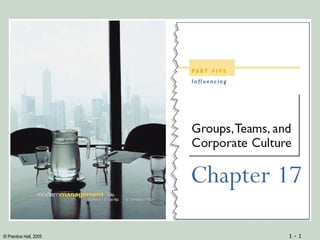More Related Content
More from Saleem Gul (20)
Chap17
- 2. Objectives
1. A definition of the term group as used in the context of management
2. A thorough understanding of the difference between formal and
informal groups
3. Knowledge of the types of formal groups that exist in organizations
4. An understanding of how managers can determine which groups exist
in an organization
5. An appreciation for what teams are and how to manage them
6. Insights into managing corporate culture to enhance organizational
success
© Prentice Hall, 2005 1-2
- 3. Groups
Group is any number of people who:
(1) interact with one another
(2) are psychologically aware of one another
(3) perceive themselves to be a group
Why managers should study groups:
1. Exist in all kinds of organizations
2. Form in all facets of organizational existence
3. Cause either desirable or undesirable consequences
4. Raise the probability of causing desirable consequences
© Prentice Hall, 2005 1-3
- 4. Kinds of Groups in Organizations
Formal Groups
Kinds of Formal Groups
Command groups
Task groups
© Prentice Hall, 2005 1-4
- 6. Kinds of Groups in Organizations
Formal Groups (continued)
Examples of Formal Groups
Committees
Reasons for establishing committees:
1. Allow organization members to exchange ideas
2. Generate suggestions and recommendations
3. Develop new ideas for solving existing organizational problems
4. Assist in the development of organizational policies
Why Managers Should Use Committees
Improve quality of decision making
Encourage expression of honest opinions
Increase members’ participation in decision-making
Ensure representation of important groups in decision-making process
© Prentice Hall, 2005 1-6
- 8. Kinds of Groups in Organizations
Formal Groups (continued)
Examples of Formal Groups (continued)
Committees (continued)
What Makes Committees Successful
Procedural Steps
Define goals clearly, preferably in writing
Specify authority
Determine optimum size
Select chairperson
Appoint permanent secretary
Distrubute agenda and support material before meeting
Start meetings on time-announce ending time at outset
People-Oriented Guidelines.
Rephrasing ideas already expressed
Bringing all members into active participation
Stimulating further thought by members
Groupthink
© Prentice Hall, 2005 1-8
- 9. Kinds of Groups in Organizations
Formal Groups (continued)
Examples of Formal Groups (continued)
Work Teams
Special-Purpose and Self-Managed Teams
Stages of Formal Group Development
The Acceptance Stage
The Communication and Decision-Making Stage
The Group Solidarity Stage
The Group Control Stage
Members function as a unit
Members participate effectively in group effort
Members are oriented toward a single goal
Members have equipment, tools, and skills necessary to attain goals
Members exchange suggestions, opinions, and information
© Prentice Hall, 2005 1-9
- 10. Kinds of Groups in Organizations
Informal Groups
Kinds of Informal Groups
Interest groups
Friendship groups
Benefits of Informal Group Membership
1. Perpetuation of social and cultural values
2. Status and social satisfaction
3. Increased ease of communication
4. Increased desirability of the overall work environment
© Prentice Hall, 2005 1 - 10
- 12. Managing Work Groups
Determining Group Existence
Sociometric Analysis
Applying the Sociogram Model
Understanding the Evolution of Informal Groups
Homans’ Model
Applying the Homans Model
© Prentice Hall, 2005 1 - 12
- 15. Teams
Groups Versus Teams
Group consists of any number of people who:
Interact with one another
Are psychologically aware of one another
Think of themselves as a group
Team is a group whose members:
Influence one another toward the accomplishment of objective(s)
Types of Teams in Organizations
Problem-Solving Teams
Self-Managed Teams
Cross-Functional Teams
© Prentice Hall, 2005 1 - 15
- 17. Teams
Stages of Team Development
Forming
Storming
Norming
Performing
Adjourning
© Prentice Hall, 2005 1 - 17
- 18. Teams
Team Effectiveness
People-related steps:
1. Trying to make the team’s work satisfying
2. Developing mutual trust among team members and
between the team and management
3. Building good communication
4. Minimizing unresolved conflicts and power struggles within the team
5. Dealing effectively with threats toward and within the team
6. Building the perception that the jobs of team members are secure
© Prentice Hall, 2005 1 - 18
- 20. Teams
Team Effectiveness (continued)
Organization-related steps:
1. Building a stable overall structure team members view as secure
2. Becoming involved in team events and
demonstrating interest in team progress and functioning
3. Properly rewarding and recognizing teams for accomplishments
4. Setting stable goals and priorities for the team
© Prentice Hall, 2005 1 - 20
- 21. Teams
Team Effectiveness (continued)
Task-related steps:
1. Developing clear objectives, directions, and project plans for the team
2. Providing proper technical direction and leadership for the team
3. Establishing autonomy for team and challenging work within the team
4. Appointing experienced and qualified team personnel
5. Encouraging team involvement
6. Building visibility within the organization for the team’s work
© Prentice Hall, 2005 1 - 21
- 22. Teams
Trust and Effective Teams
Communicate often to team members
Show respect for team members
Be fair to team members
Be predictable
Demonstrate competence
© Prentice Hall, 2005 1 - 22
- 23. Corporate Culture
Status Symbols
Traditions and History
Physical Environment
The Significance of Corporate Culture
Mechanisms for developing and reinforcing desired corporate culture:
What leaders pay attention to, measure, and control
Leaders’ reactions to critical incidents and organizational crises
Deliberate role modeling, teaching, and coaching
Criteria for allocation of rewards and status
Criteria for employee recruitment, selection, promotion, and retirement
© Prentice Hall, 2005 1 - 23

